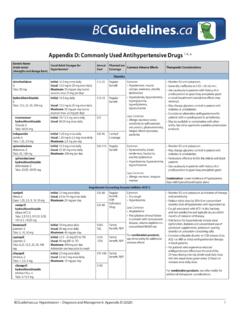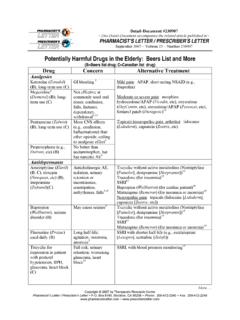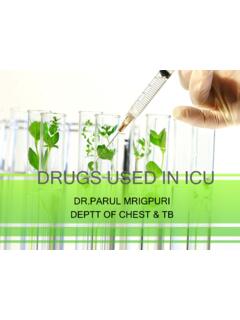Transcription of Drugs to Avoid in G6PD Deficiency Background: Glucose 6 ...
1 Drugs to Avoid in G6PD Deficiency Background: Glucose 6-phosphate dehydrogenase (G6PD) Deficiency is a genetic blood disorder where an acute attack of a haemolytic anaemia occurs. It is highly common in certain ethnic groups such as: Asians, Africans and Mediterranean and more prevalent in males more than females (1,2). The clinical expression of Glucose 6-phosphate dehydrogenase (G6PD) Deficiency encompasses a spectrum of hemolytic syndromes, with the most prevalent G6PD variants (G6PD A- and G6PD Mediterranean). While affected patients are usually asymptomatic, some have episodic anemia while a few have chronic hemolysis (3). The symptoms: Sudden rise of body temperature and yellow colouring of skin and mucous membrane.
2 Dark yellow-orange urine . Pallor, fatigue, general deterioration of physical conditions . Heavy, fast breathing . Weak, rapid pulse (2). Severe acute hemolysis is induced by the sudden destruction of older, more deficient erythrocytes after exposure to certain triggers including Drugs having a high redox potential or to fava beans, selected infections, or metabolic abnormalities (1,3). These Drugs according to their pharmacological groups and possibility of risk of are listed below: G6PD Deficiency drug Interaction Definite Risk of Haemolysis Possible Risk of Haemolysis Anthelmintic -Napthol Niridazole Stibophen Analgesics Acetylsalycylic Acid (Aspirin) Paracetamol (Acetaminophen) Antibiotics Nitrofurans: Nitrofurantoin Quinolones: Ciprofloxacin Moxifloxacin Norfloxacin Ofloxacin Chloramphenicol Sulfonamides.
3 Co-trimoxazole (Sulfamethoxazole + Trimethoprim) Sulfamethoxazole Sulfadiazine Sulfapyridine Salazosulfapyiridine Anticonvulsants Phenytoin Antidiabetics Glibenclamide Antihistamines Antazoline (Antisine) Diphenhydramine antihypertensive Hydralazine Methyldopa Antimalarials Chloroquine and derivatives Proguanil Quinine Antimycobacterials Isoniazide Antimalarials Primaquine Antiparkinsonism Agents Triphexayphenidyl (Benzhexol) Antimethemo-globianmeic Agents Methylene blue Cardiovascular Drugs Dopamine (L-dopa) Antimycobacterials Dapsone Para-aminosalicylic acid ( 5-aminosalicylic acid) Gout Preparations Colchicine Hormonal Contraceptives Mestranol Genitourinary Analgesics Phenazopyridine (Pyridium) Vitamin K Substances Phytomenadione Vitamins Ascorbic Acid (Vitamin C) Others Para-aminobenzoic acid Note: When prescribing Drugs for patients with G6PD Deficiency , the following three points should be kept in mind: G6PD Deficiency is genetically heterogeneous; susceptibility to the haemolytic risk from Drugs varies; thus, a drug found to be safe in some G6PD-deficient individuals may not be equally safe in others; Manufacturers do not routinely test Drugs for their effects in G6PD-deficient individuals.
4 The risk and severity of hemolysis is almost always dose-related. References: 1) BNF69 2) 3)



